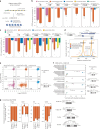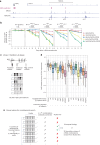Engineered CRISPR-Cas12a for higher-order combinatorial chromatin perturbations
- PMID: 38760567
- PMCID: PMC11919711
- DOI: 10.1038/s41587-024-02224-0
Engineered CRISPR-Cas12a for higher-order combinatorial chromatin perturbations
Abstract
Multiplexed genetic perturbations are critical for testing functional interactions among coding or non-coding genetic elements. Compared to double-stranded DNA cutting, repressive chromatin formation using CRISPR interference (CRISPRi) avoids genotoxicity and is more effective for perturbing non-coding regulatory elements in pooled assays. However, current CRISPRi pooled screening approaches are limited to targeting one to three genomic sites per cell. We engineer an Acidaminococcus Cas12a (AsCas12a) variant, multiplexed transcriptional interference AsCas12a (multiAsCas12a), that incorporates R1226A, a mutation that stabilizes the ribonucleoprotein-DNA complex via DNA nicking. The multiAsCas12a-KRAB fusion improves CRISPRi activity over DNase-dead AsCas12a-KRAB fusions, often rescuing the activities of lentivirally delivered CRISPR RNAs (crRNA) that are inactive when used with the latter. multiAsCas12a-KRAB supports CRISPRi using 6-plex crRNA arrays in high-throughput pooled screens. Using multiAsCas12a-KRAB, we discover enhancer elements and dissect the combinatorial function of cis-regulatory elements in human cells. These results instantiate a group testing framework for efficiently surveying numerous combinations of chromatin perturbations for biological discovery and engineering.
© 2024. The Author(s).
Conflict of interest statement
Competing interests: C.C.H., C.M.W., R.D. and L.A.G. have filed patent applications related to multiAsCas12a. J.S. is a scientific consultant for Treeline Biosciences. L.A.G. has filed patents on CRISPRoff/on and CRISPR functional genomics and is a co-founder of Chroma Medicine. The other authors declare no competing interests.
Figures






Update of
-
Higher-order combinatorial chromatin perturbations by engineered CRISPR-Cas12a for functional genomics.bioRxiv [Preprint]. 2024 Feb 9:2023.09.18.558350. doi: 10.1101/2023.09.18.558350. bioRxiv. 2024. Update in: Nat Biotechnol. 2025 Mar;43(3):369-383. doi: 10.1038/s41587-024-02224-0. PMID: 37781594 Free PMC article. Updated. Preprint.
References
-
- Wong, A. S. L., Choi, G. C. G. & Lu, T. K. Deciphering combinatorial genetics. Annu. Rev. Genet.50, 515–538 (2016). - PubMed
-
- Domingo, J., Baeza-Centurion, P. & Lehner, B. The causes and consequences of genetic interactions (epistasis). Annu. Rev. Genomics Hum. Genet.20, 433–460 (2019). - PubMed
-
- Takahashi, K. & Yamanaka, S. Induction of pluripotent stem cells from mouse embryonic and adult fibroblast cultures by defined factors. Cell126, 663–676 (2006). - PubMed
-
- Ewen-Campen, B., Mohr, S. E., Hu, Y. & Perrimon, N. Accessing the phenotype gap: enabling systematic investigation of paralog functional complexity with CRISPR. Dev. Cell43, 6–9 (2017). - PubMed
MeSH terms
Substances
Grants and funding
- S10 OD028511/OD/NIH HHS/United States
- UM1 HG012660/HG/NHGRI NIH HHS/United States
- OT2 CA278665/CA/NCI NIH HHS/United States
- R01 HG012227/HG/NHGRI NIH HHS/United States
- K01 HG012789/HG/NHGRI NIH HHS/United States
- DP2 CA239597/CA/NCI NIH HHS/United States
- R01HG012227/U.S. Department of Health & Human Services | NIH | National Human Genome Research Institute (NHGRI)
- K01HG012789/U.S. Department of Health & Human Services | NIH | National Human Genome Research Institute (NHGRI)
- DP2CA239597/U.S. Department of Health & Human Services | NIH | National Cancer Institute (NCI)
- UM1HG012660/U.S. Department of Health & Human Services | NIH | National Human Genome Research Institute (NHGRI)
LinkOut - more resources
Full Text Sources
Molecular Biology Databases
Research Materials

